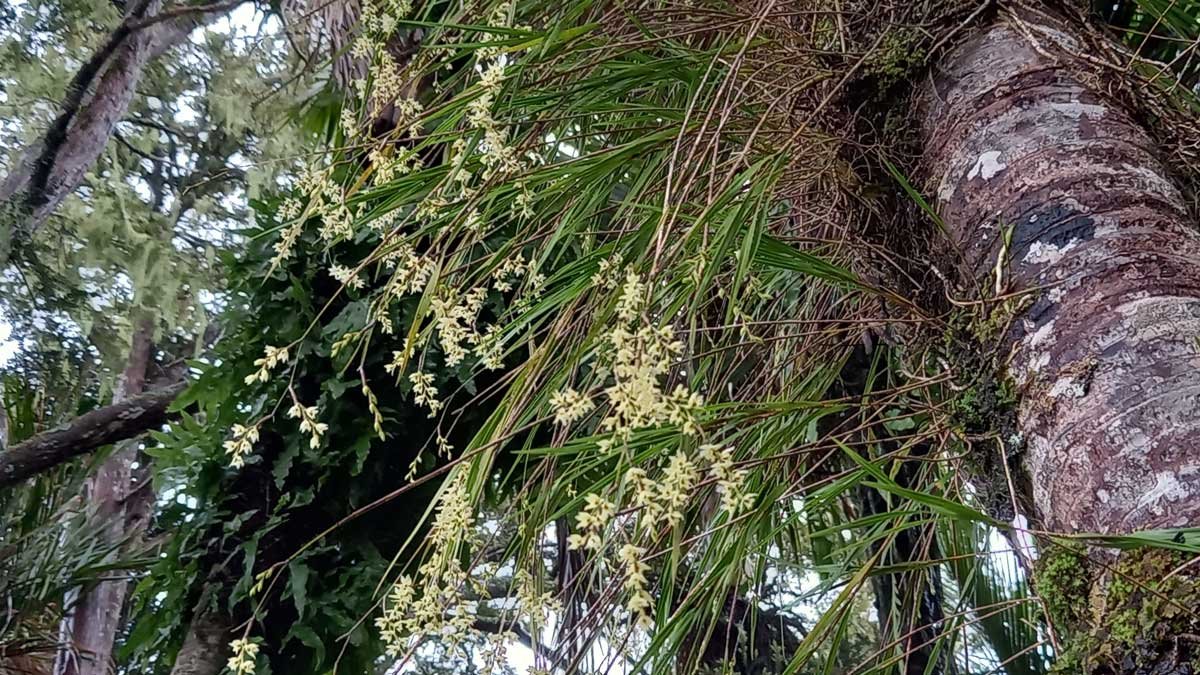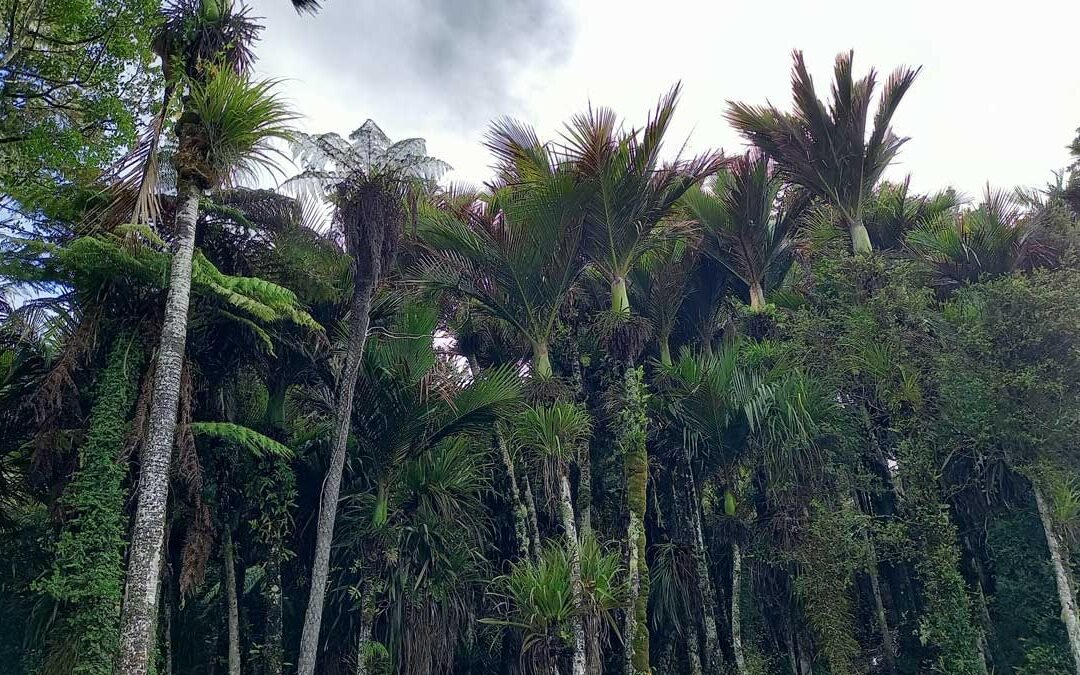I’ve spent the last few years learning to see the trees for the forest. It’s a real trip.
For most of my life I’ve looked at native bush and my brain has registered “native bush”. I could tell the difference between “native bush”, or “pine forest”. I might specifically notice a “tree fern”, “palm”, “pretty flower” or “big-ass-giant-tree”; but honestly the only native plant I genuinely recognised was the one I called the ‘toilet-paper bush’ (rangiora, Brachyglottis repanda). It seemed like a handy one to know.
When I decided I needed to learn more about New Zealand’s native plants, I found the hardest bit was actually learning to see them. Turns out, that’s a cognitive bias called plant blindness. You may be familiar with it – my experience says it’s pretty common.
Despite calling myself a gardener, plant blindness affected what I saw in all sorts of places: garden centers, in the forest, in parks, and in people’s gardens. My eye just kind of ‘skips’ over the things my brain doesn’t recognise. Learning to stop and see each plant has been an evolution of experiences and interests that have developed in layers over years. Now I can walk through a garden and recognise all sorts of treasures – but that is a fairly recent development.
I still have plant blindness – and have a lot of empathy for people who get overwhelmed in garden centers – but I’ve also begun to hone my eye. Especially in our native bush block.
In the clouds
Since moving to The Outpost, I’ve become familiar with a large number of the natives that grow in our native bush. The easiest were our canopy species.

I can spot a taraire (Beilschmiedia tarairi), even if its branches are many meters above my head. It likes to send its thick leathery leaves to the forest floor below, and – at the right time of year – fat juicy purple fruit.



When is a tree not a tree?
Having wrapped my head around a few of our canopy trees, I started to notice that most of the time, one tree is not just one tree.
Entire ecosystems on each trunk started to appear as I looked closer. Where I once saw ‘bush’, followed by specific trees, now I started to see how much life one tree actually holds. In some places, you can find half a dozen plant species on a single tree trunk.



Kahakaha (Collospermum hastatum) also grow on other trees. Look closely and there are a dozen or so hanging from the trees in the above photo (or cheat and click this link to have them pointed out).
They can grow to the size of a small car. This is even more impressive when you look up to see them perched so precariously in spaces where gravity should probably have other ideas. We find them strewn over the forest floor after big winds, and they are the reason we only explore the bush on calm days – they are a plant that has earned their common name.

Occasionally I see something quite random – like a mapou (Myrsine australis) seedling growing on a former-kahaha perch in midair above my head. Or a griselinia hanging off the side of a nikau palm. Often, these are things I’ve been walking past for ages, but just never noticed.
Lockdown hobbies
On the second day of New Zealand’s latest Level 4 lockdown, I noticed a tweet inviting people to an online workshop to learn about WikiSource. It’s a sister-site to Wikipedia designed to upload, edit, and host public domain books. By the end of the virtual learning session that afternoon, I’d picked up a new hobby.
And I’ve spent my Lockdown pottering away helping to format, proofread, and digitise C.F. Cheeseman’s Manual of the New Zealand Flora (1906). I picked a place to begin at random and found myself in the middle of the ferns. Turns out, New Zealand has quite a lot of ferns. There are over 130 of them in this particular book. I’m still chipping away at it.
The information is pretty out-of-date: it’s been over 100 years since the book was published. Measurements are in fractions of inches. Many of the families have been moved around, re-named and consolidated in the time between publication and where I sit in 2021, proofing the digital scan at home during a global pandemic.
But it made me really curious: if Cheeseman is to be believed, I should find dozens of different ferns in our bush block. Maybe I hadn’t been looking close enough.
Field trip
So I wandered down to a small patch of our bush – I was still very much within the boundaries of our property, and I didn’t need to go very far. When I looked for ferns, I found them. Different types of tree-fern. Ground ferns. Ferns that grow up trunks. Ferns that grow as epiphytes.
Of course, I didn’t know what any of them were, despite being about 50% of the way through the ‘Filices’ section of Cheeseman. The book is filled with botanical terminology I haven’t get my head around yet. Thankfully, I live in 2021, so I took some photos. I uploaded four observations to iNaturalist. Then I had a nap.
By the time I woke up, volunteers had provided identification for three of them: hound’s tongue fern, fragrant fern, and thread fern.
The history of plants
Cheeseman knew hound’s tongue fern as Polypodium pustulatum, but today it’s known as Zealandia pustulata. In our bush, it likes to grow as an epiphyte – frequently under kahakaha, but it also loves to ‘cloak’ the trunks of nikau as shown below.

I thought that I would find fragrant fern under Polypodium scandens in Cheeseman, but it wasn’t listed in the index. Funnily enough, I found a small mention of it under Polypodium pustulatum (hound’s tooth fern):
I keep finding moments like this – where the plant dudes of yore take little swipes at each other. For whatever reason, Cheeseman didn’t include fragrant fern in his manual. Today, it is classified as Dendroconche scandens.

Thread fern is currently known as Icarus filiformis, having been reclassified in 2016. But Cheeseman knew it as Lomaria filiformis.

Funnily enough, Cheeseman includes a note that says “A most distinct species, remarkable for its very long climbing rhizome and dimorphic sterile fronds.” (p. 982). In 2016, it was put into its own genus all by itself, that’s how distinct it is!
A public good
One day – perhaps many, many days from now – Cheeseman’s Manual will be fully searchable and accessible. Despite its antiquated language and pithy fights between long-dead white dudes, it still holds value, and I am finding value in it. I’m maybe half way through the ferns. There are hundreds of pages and dozens of plant families to go before I run out of things to do. If you feel inspired, feel free to get involved.
I’m sure there are still many things I’m not seeing right in front of my eyes. As I satisfy my curiousity about the plants around me, I turn to iNaturalist a lot. Volunteers who know more than me then help improve my understanding of how special this environment really is.
As a small thanks to the volunteer and scientific communities that make that magic happen, I’ve set my ‘Research Grade’ photos (photos that have been ID’d by at least 2 people) on iNaturalist to be automatically released into the public domain.

This is a New Zealand bamboo orchid (Earina mucronata). I stumbled across it while taking photos for this blog. I’ve learned through iNaturalist that it’s quite unusual for them to flower this early. There are quite a few on nearby trunks and it is the only one I saw in flower.
This allows them to be used for anything. But I’m primarily motivated by a feeling of importance to document what is here, now. Just as the dead white dudes documented what was here during early colonialisation.
There will be changes – both in what is distributed where, how much we understand of it, and what we call it. Agriculture, land management, pest burden, weed pressure, and climate change will all have an impact on what grows where, and how it behaves. Perhaps one day, someone else may be able to use it all to make new connections that were right in front of our faces all along.


